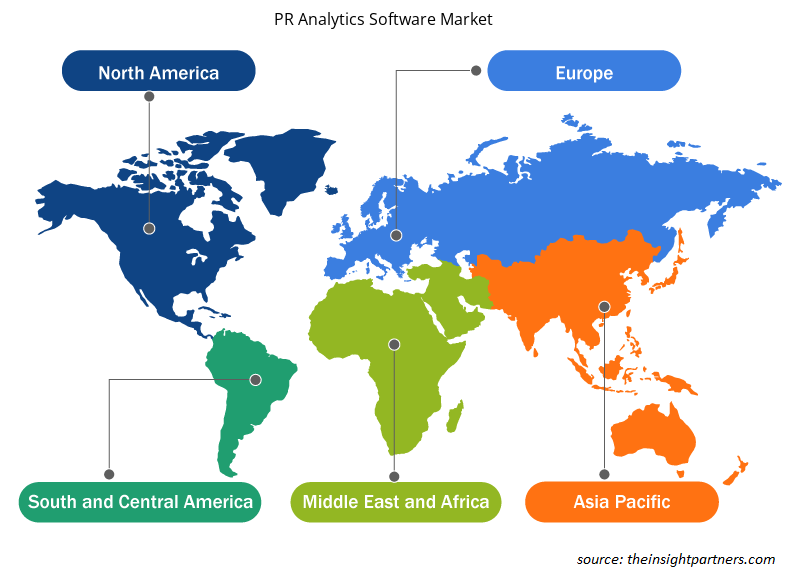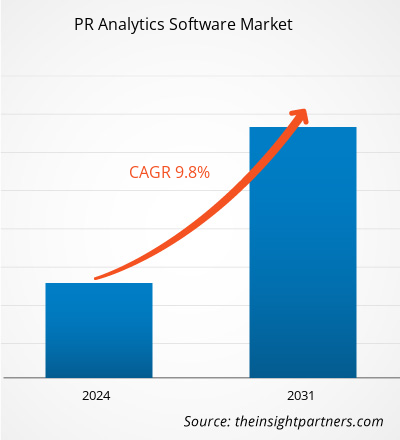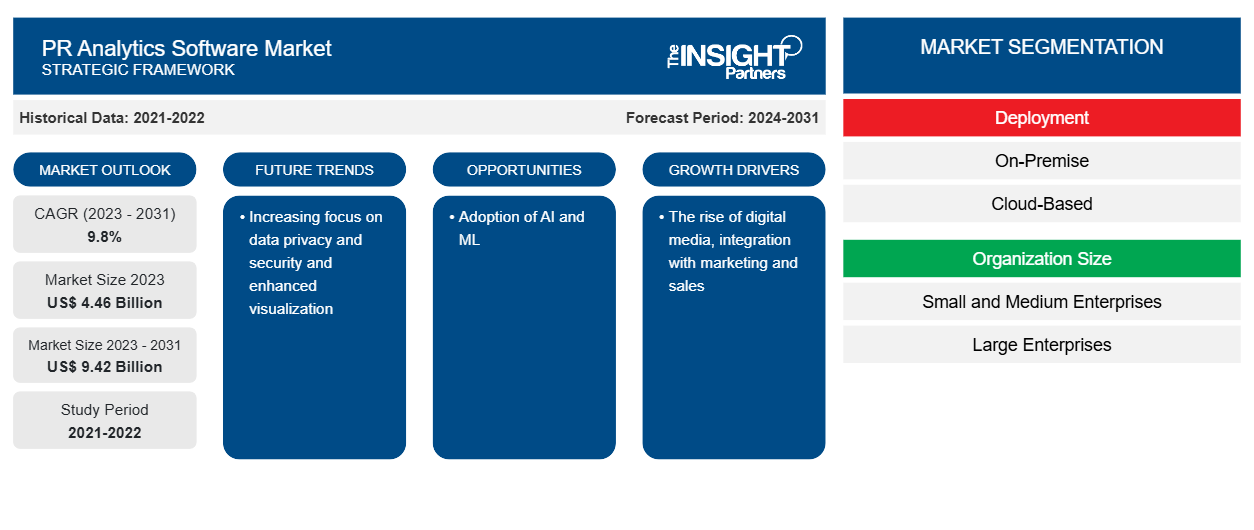Se prevé que el tamaño del mercado de software de análisis de relaciones públicas alcance los 9.420 millones de dólares en 2031, frente a los 4.460 millones de dólares en 2023. Se espera que el mercado registre una CAGR del 9,8 % durante el período 2023-2031. Es probable que el enfoque creciente en la privacidad y la seguridad de los datos y las herramientas de visualización mejoradas sigan siendo una tendencia clave en el mercado.CAGR of 9.8% during 2023–2031. Increasing focus on data privacy and security and enhanced visualization tools are likely to remain a key trend in the market.
Análisis del mercado de software de análisis de relaciones públicas
En el vertiginoso mundo actual de las relaciones públicas y la comunicación, los profesionales que buscan mejorar sus tácticas y su eficacia ahora descubren que la toma de decisiones basada en datos es esencial. La medición profesional y el análisis de relaciones públicas son esenciales para obtener información significativa a partir de los datos. El análisis de relaciones públicas consiste en recopilar, examinar y extrapolar información sobre la atención de los medios, la actividad en las redes sociales, las iniciativas de relaciones públicas y otros temas.
Descripción general del mercado de software de análisis de relaciones públicas
La industria de las relaciones públicas está en constante cambio para satisfacer las necesidades en constante evolución del mundo acelerado en el que vivimos hoy. En los últimos años han proliferado nuevas tecnologías, ideas creativas y tácticas de relaciones públicas con visión de futuro, lo que ha dado lugar a avances inesperados en este campo en constante cambio. Los datos son el motor de las relaciones públicas contemporáneas. Las empresas de relaciones públicas dependen cada vez más de métodos basados en datos en el análisis de relaciones públicas para orientar sus tácticas. Los datos ofrecen pruebas concretas para respaldar las iniciativas de comunicación, lo que facilita la comunicación con audiencias específicas y mensajes precisos.
Personalice este informe según sus necesidades
Obtendrá personalización en cualquier informe, sin cargo, incluidas partes de este informe o análisis a nivel de país, paquete de datos de Excel, así como también grandes ofertas y descuentos para empresas emergentes y universidades.
-
Obtenga las principales tendencias clave del mercado de este informe.Esta muestra GRATUITA incluirá análisis de datos, desde tendencias del mercado hasta estimaciones y pronósticos.
Factores impulsores y oportunidades del mercado del software de análisis de relaciones públicas
El auge de los medios digitales favorece al mercado
Para explorar el enorme mundo digital y profundizar en sus conocimientos, las personas dependen cada vez más de plataformas digitales, como las redes sociales y los motores de búsqueda como Google y Bing. Según la Oficina del Censo de Estados Unidos, los ingresos de las editoriales de periódicos cayeron un 52% entre 2002 y 2020, mientras que el número de diarios publicados en Estados Unidos disminuyó de 55,8 millones en 2000 a 24,2 millones en días laborables en el mismo año. Este aumento constante de los medios digitales ha provocado un aumento en los volúmenes de datos generados, que pueden aprovecharse mediante el uso de software de análisis de relaciones públicas por parte de las empresas de relaciones públicas, lo que impulsa la demanda.
Adopción de IA y ML
Las herramientas de software de análisis de relaciones públicas se utilizan para manejar grandes volúmenes de datos de relaciones públicas. Las relaciones públicas están cambiando como resultado del aprendizaje automático y la inteligencia artificial. La previsión de tendencias, la personalización de mensajes y el comportamiento del cliente son posibles gracias a los algoritmos y el análisis de datos. Estas herramientas, que van desde los chatbots hasta el análisis de sentimientos de las relaciones públicas, son útiles para los profesionales de las relaciones públicas, pero requieren un uso responsable y abierto para mantener la confianza del cliente.personalization, and customer behavior are all made possible by algorithms and data analysis. These tools, which range from chatbots to sentiment PR analytics, enable PR practitioners but require responsible and open use to maintain customer confidence.
Informe de mercado de software de análisis de relaciones públicas Análisis de segmentación
Los segmentos clave que contribuyeron a la derivación del análisis del mercado de software de análisis de relaciones públicas son la implementación y el tamaño de la organización.
- Según la implementación, el mercado de software de análisis de relaciones públicas se divide en local y basado en la nube. El segmento basado en la nube tuvo la mayor participación en 2023.
- Según el tamaño de la organización, el mercado se divide en pequeñas y medianas empresas y grandes empresas.
Análisis de la cuota de mercado del software de análisis de relaciones públicas por geografía
El alcance geográfico del informe de mercado de software de análisis de relaciones públicas se divide principalmente en cinco regiones: América del Norte, Asia Pacífico, Europa, Medio Oriente y África, y América del Sur y Central.
América del Norte posee una participación significativa del mercado de software de análisis de relaciones públicas en 2023. La región alberga las principales empresas de relaciones públicas del mundo, como Cision, Meltwater y Brandwatch. Es un mercado maduro con una demanda creciente de análisis de relaciones públicas en países como Estados Unidos y Canadá. Esto está impulsando el crecimiento del mercado en la región.Cision, Meltwater, and Brandwatch. It is a mature market with rising demand for PR analytics within countries such as the US and Canada. This is driving the market growth in the region.
Perspectivas regionales del mercado de software de análisis de relaciones públicas
Los analistas de Insight Partners explicaron en detalle las tendencias y los factores regionales que influyen en el mercado de software de análisis de relaciones públicas durante el período de pronóstico. Esta sección también analiza los segmentos y la geografía del mercado de software de análisis de relaciones públicas en América del Norte, Europa, Asia Pacífico, Oriente Medio y África, y América del Sur y Central.

- Obtenga datos regionales específicos para el mercado de software de análisis de relaciones públicas
Alcance del informe de mercado de software de análisis de relaciones públicas
| Atributo del informe | Detalles |
|---|---|
| Tamaño del mercado en 2023 | US$ 4.46 mil millones |
| Tamaño del mercado en 2031 | US$ 9,42 mil millones |
| CAGR global (2023 - 2031) | 9,8% |
| Datos históricos | 2021-2022 |
| Período de pronóstico | 2024-2031 |
| Segmentos cubiertos |
Por implementación
|
| Regiones y países cubiertos |
América del norte
|
| Líderes del mercado y perfiles de empresas clave |
|
Densidad de actores del mercado de software de análisis de relaciones públicas: comprensión de su impacto en la dinámica empresarial
El mercado de software de análisis de relaciones públicas está creciendo rápidamente, impulsado por la creciente demanda de los usuarios finales debido a factores como la evolución de las preferencias de los consumidores, los avances tecnológicos y una mayor conciencia de los beneficios del producto. A medida que aumenta la demanda, las empresas amplían sus ofertas, innovan para satisfacer las necesidades de los consumidores y aprovechan las tendencias emergentes, lo que impulsa aún más el crecimiento del mercado.
La densidad de actores del mercado se refiere a la distribución de las empresas o firmas que operan dentro de un mercado o industria en particular. Indica cuántos competidores (actores del mercado) están presentes en un espacio de mercado determinado en relación con su tamaño o valor total de mercado.
Las principales empresas que operan en el mercado de software de análisis de relaciones públicas son:
- Presly
- Soluciones de relaciones públicas de Agility LLC
- Mención crítica, Inc.
- Aguanieve
- Rejilla para estiércol
- Onclusive, Inc
Descargo de responsabilidad : Las empresas enumeradas anteriormente no están clasificadas en ningún orden particular.

- Obtenga una descripción general de los principales actores clave del mercado de software de análisis de relaciones públicas
Noticias y desarrollos recientes del mercado de software de análisis de relaciones públicas
El mercado de software de análisis de relaciones públicas se evalúa mediante la recopilación de datos cualitativos y cuantitativos a partir de una investigación primaria y secundaria, que incluye publicaciones corporativas importantes, datos de asociaciones y bases de datos. A continuación, se enumeran algunos de los avances en el mercado de software de análisis de relaciones públicas:
- Critical Mention ahora se integra con Google Analytics, una herramienta crucial para los profesionales de marketing y relaciones públicas orientados a los datos. Los clientes de Critical Mention ahora pueden ver las métricas de Google Analytics directamente en los informes de Critical Mention. La integración de informes es la última de una serie de importantes lanzamientos recientes, que incluyen una base de datos de contactos de medios líder en la industria y monitoreo de podcasts. (Fuente: Critical Mention, Inc, comunicado de prensa, marzo de 2021)
- Meltwater anuncia hoy nuevas innovaciones de productos impulsadas por IA en su conjunto de soluciones que permiten a los clientes ahorrar tiempo, descubrir información más detallada y tomar medidas. Con este último lanzamiento, Meltwater ha consolidado su liderazgo en innovación de IA, lanzando al mercado dos nuevos asistentes de escritura diseñados para ahorrar tiempo a los equipos y nuevas capacidades de resumen impulsadas por IA que muestran información valiosa a los clientes sin necesidad de trabajo manual. (Fuente: Meltwater, comunicado de prensa, junio de 2023)
Informe de mercado sobre software de análisis de relaciones públicas: cobertura y resultados
El informe “Tamaño y pronóstico del mercado de software de análisis de relaciones públicas (2021-2031)” proporciona un análisis detallado del mercado que cubre las siguientes áreas:
- Tamaño y pronóstico del mercado de software de análisis de relaciones públicas a nivel global, regional y nacional para todos los segmentos clave del mercado cubiertos bajo el alcance
- Tendencias del mercado de software de análisis de relaciones públicas, así como dinámicas del mercado, como impulsores, restricciones y oportunidades clave
- Análisis detallado de las cinco fuerzas de Porter y PEST y FODA
- Análisis del mercado de software de análisis de relaciones públicas que cubre las tendencias clave del mercado, el marco global y regional, los principales actores, las regulaciones y los desarrollos recientes del mercado.
- Análisis del panorama de la industria y de la competencia que abarca la concentración del mercado, el análisis de mapas de calor, los actores destacados y los desarrollos recientes del mercado de software de análisis de relaciones públicas
- Perfiles detallados de empresas
- Análisis histórico (2 años), año base, pronóstico (7 años) con CAGR
- Análisis PEST y FODA
- Tamaño del mercado, valor/volumen: global, regional y nacional
- Industria y panorama competitivo
- Conjunto de datos de Excel
Informes recientes
Informes relacionados
Testimonios
Razón para comprar
- Toma de decisiones informada
- Comprensión de la dinámica del mercado
- Análisis competitivo
- Información sobre clientes
- Pronósticos del mercado
- Mitigación de riesgos
- Planificación estratégica
- Justificación de la inversión
- Identificación de mercados emergentes
- Mejora de las estrategias de marketing
- Impulso de la eficiencia operativa
- Alineación con las tendencias regulatorias























 Obtenga una muestra gratuita para - Mercado de software de análisis de relaciones públicas
Obtenga una muestra gratuita para - Mercado de software de análisis de relaciones públicas